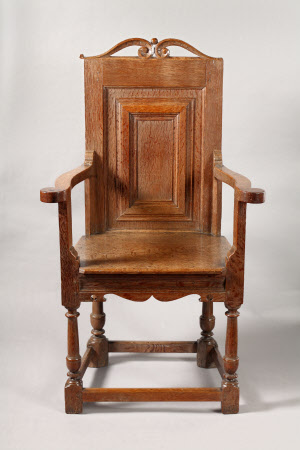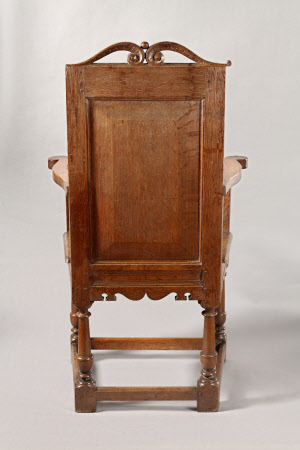Panel-back armchair
Category
Furniture
Date
circa 1570
Materials
Carved, turned and joined oak
Measurements
121.5 x 59 x 43.5 cm
Place of origin
Westmorland (England)
Order this imageCollection
Sizergh Castle, Cumbria
NT 997991
Summary
A panel-back open armchair, English, probably Westmorland, circa 1570. Joined with round pegs. The highly unusual cresting pierced with a pair of 'S'-scrolls, moulded and carved with a run of 'I' shapes. The centre of the cresting, where the ends of the scrolls meet, topped by a ball. The back framing a panel applied with mouldings to form a rectangle; the reverse of the panel chamfered. The seat boarded and between flat, scrolling arms with circular terminals. The arms on 'stepped' arm supports descending to vase- and ring-turned front legs, with block feet. The rear legs turned in the same way. All joined by plain foot stretchers. The seat rails moulded, and with ogee-shaped bottom edge.
Full description
This chair is clearly part of the group of seat furniture at Sizergh which includes NT 997985 (dated 1571), the pair of chairs NT 997986.1 & .2 (dated 1570) and NT 997990 (with alterations) which is Elizabethan but undated. Stylistic similarities, such as the mouldings applied to the back panel, the turnings and the shaped seat rails, shared by this chair and the dated examples strongly suggest that this example (and NT 997990) was made at the same time, circa 1570. This back panel is applied with mouldings to form a large rectangle. It was possibly made, therefore, to sit in either the now-called Dining Room (in 1569 this was Walter Strickland's 'Great Chamber') whose overmantel is dated 1564, or in the next-door Queen's Room (in 1569 this was Walter Strickland's 'Withdrawing Chamber') which contains an overmantel dated 1569, both of which have panels decorated with mouldings forming rectangles. The legs of this chair are different to those to the other chairs, but it shares some of its highly unusual features with the pair NT 997986.1 & 2. All three chairs have turned front and rear supports, which is a highly unusual feature found only on the most sophisticated examples of this type of chair, and all three have shaped seat rails and unusual stepped front arm supports. They also share the unusual rear uprights which widen at and beneath the point where the arms join it. Comparable too are the arm profiles, and the small scrolls which terminate the cresting at either end. These features suggest that these three chairs were all made by the same hand. The inventory of Sizergh taken on 27th April 1569 associated with Walter Strickland's will mentions various chairs; the one in the Lord's Chamber - the most expensive - was 3s 4d. A publication of 1908 by Daniel Scott transcribes another document, taken on 28th June 1569, which lists the contents of some rooms, but groups other pieces by category under titles such as 'Woddewarke'. 8 'newe chayres' were listed, as were one 'ney [new?] lytle chayres for a woman or chyld' and two 'old chayres off lynd' [lime?]. (Megan Wheeler, 2016)
Provenance
Probably commissioned by Walter Strickland (1516 - 1569) and/or his wife Alice (d. 1588), thence by descent until given by Henry Hornyold Strickland (1890 – 1975) with Sizergh Castle and its estates in 1950.
Credit line
Megan Wheeler
References
Scott (1908), Daniel Scott, The Stricklands of Sizergh Castle, p. 109


